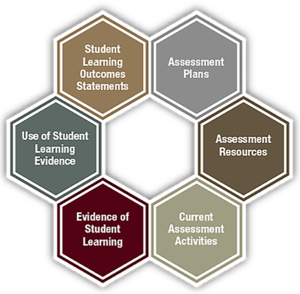Assessment
Our work provides guidance for assessing and documenting efforts to improve teaching outcomes. Using the National Institute for Learning Outcomes Assessment’s Transparency Framework, we help the University demonstrate educational effectiveness. Find assessment resources and learn more about the work we do below, or contact us if you have any questions.
Assessment model areas
Our assessment model is broken up into six key areas. Explore these topic areas to get more in-depth information and to get assessment support for courses.

Assessment framework
The National Institute for Learning Outcomes Assessment’s Transparency Framework helps guide assessment efforts at the University. Reference this graphic for guidance, or visit the National Institute for Learning Outcomes Assessment website.
Assessment resources
Our assessment resources encompass information and training provided to faculty and staff to help them understand, develop, implement, communicate, and use evidence of student learning.
Current assessment activities
Current assessment activities include information on a full range of projects and activities recently completed or currently underway to gauge student learning, make improvements, or respond to accountability interests.
Evidence of student learning
Evidence of student learning includes results of assessment activities. This may include evidence of indirect (e.g. surveys) and direct (e.g. portfolio) student learning as well as institutional performance indicators (e.g. licensure pass rate).
Use of student learning evidence
This component represents the extent to which evidence of student learning is used to identify areas where changes in policies and practices may lead to improvement. This process includes evaluating evidence to:
- Inform institutional decision-making
- Identify problems
- Set goals
- Provide faculty development opportunities
- Revise courses
- Review programs
- Run an accountability or accreditation self-study
Our team
Educational Effectiveness Assessment Committee
The University Committee for Educational Effectiveness Assessment uses this framework and structure to guide our assessment efforts. See who makes up the committee, and reach out if you have questions.
